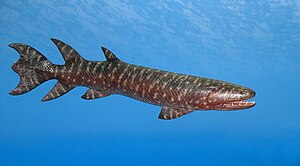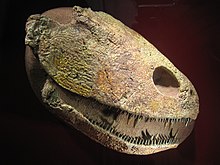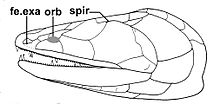Tristichopteridae
| Tristichopteridae | ||||||||||||
|---|---|---|---|---|---|---|---|---|---|---|---|---|

Live reconstruction of Eusthenopteron |
||||||||||||
| Temporal occurrence | ||||||||||||
| Givetium (Middle Devon) to Famennium (Upper Devon ) | ||||||||||||
| 387.7 to 358.9 million years | ||||||||||||
| Locations | ||||||||||||
|
||||||||||||
| Systematics | ||||||||||||
|
||||||||||||
| Scientific name | ||||||||||||
| Tristichopteridae | ||||||||||||
| Cope , 1889 |
The Tristichopteridae ( Syn .: Eusthenopteridae) are an extinct family of fish from the class of the meat fin (Sarcopterygii), which occurred from the Middle Devon to the Upper Devon . Fossils of the family have been found in the northern hemisphere, the former continent Laurussia , as well as in Antarctica and in Australia (together with Africa and South America they formed the major continent Gondwana ). The Tristichopteridae represent the most species-rich radiation of tetrapodomorphic fish, first developed in Laurussia and were probably distributed worldwide in the late Devonian. Different Tristichopteriden of different sizes occurred at the same time in the same place and must have occupied different ecological niches . At the end of the Devonian they fell victim to an extinction event . Their ecological niches were occupied by meat fins from the families of the Megalichthyidae and Rhizodontidae .
The Tristichopteridae includes Eusthenopteron , one of the best-known and best-researched extinct fish, which has been intensively researched by the Swedish paleozoologist Erik Jarvik and is of great importance for the understanding of the landfall of terrestrial vertebrates (Tetrapoda).
features
The Tristichopteridae were medium-sized ( Tristichopterus , 30 cm) to very large fish, the largest forms ( Hyneria ) could be several meters long, had teeth up to 30 cm long and were the largest predatory fish in their fauna communities. The Tristichopteridae had a strongly developed fin skeleton, which probably enabled them to briefly leave the water. In the skeleton of the front fins, which are set deeply, the elements of what will later become the front leg of the terrestrial vertebrates , the humerus , ulna and radius , can already be recognized. The parts of the bones facing outward from the trunk were flattened. The pelvis had long, tapered pubis ramui, which may have met in a cartilaginous symphysis . The pelvic fins also contained the most important bones of the hind legs, thigh bones , tibia and fibula . Ankle bones (tarsal bones) and toes cannot yet be recognized. The limbs were facing sideways and could only be moved back and forth about 20 to 25 degrees. The anal fin sat on a basal, fleshy stalk. The caudal fin was three-lobed (triphycerk), with basal forms initially asymmetrical and with later forms more and more symmetrical externally. In the family there were only modern round scales with a medium protrusion on the inside and without a cosmin layer .

Genera
- Cabonnichthys , Upper Devonian New South Wales , Australia.
- Edenopteron , Upper Devonian New South Wales , Australia.
- Eusthenodon , Famennium of Greenland, Pennsylvania , Belgium, Russia, Australia and South Africa.
- Eusthenopteron , Frasnium of Eastern Canada, Latvia and Great Britain.
- Heddleichthys , Famennium of Scotland.
- Hyneria , Famennium of Pennsylvania.
- Jarvikina , frasnium of the Baltic States .
- Langlieria , Famennium of Belgium.
- Mandageria , Upper Devonian New South Wales.
- Notorhizodon , Givetium of the Antarctic.
- Platycephalichthys , Upper Devonian of Latvia.
- Tristichopterus , Givetium of the Orkney and Shetland Islands .
Systematics
In the past, the Tristichopteridae were assigned to the Osteolepiformes , a group of meat-flossers that is now considered paraphyletic . Today they form the order Eotetrapodiformes with some other taxa that are even closer to the terrestrial vertebrates . The sister taxon of the Tristichopteridae is Spodichthys , which is very similar to the Tristichopteridae, but differs from them by the position of the extra-temporal bone (skull bone).
The systematic position shows the following cladogram (here Platycephalichthys no longer belongs to the Tristichopteridae):
| Tetrapodomorpha |
|
|||||||||||||||||||||||||||||||||||||||||||||||||||||||||||||||||||||||||||||||||||||||||||||||||||
|
|
literature
- Michael J. Benton : Paleontology of the vertebrates. 2007, ISBN 3-8993-7072-4
- Kurt Fiedler: Textbook of Special Zoology, Volume II, Part 2: Fish . Gustav Fischer Verlag Jena, 1991, ISBN 3-334-00339-6
- Daniel Snitting: Morphology, Taxonomy and Interrelationships of Tristichopterid Fishes (Sarcopterygii, Tetrapodomorpha). PhD thesis online
Individual evidence
- ↑ Ben Young, Robert L. Dunstone, Timothy J. Senden & Gavin C. Young: A Gigantic Sarcopterygian (Tetrapodomorph Lobe-Finned Fish) from the Upper Devonian of Gondwana (Eden, New South Wales, Australia) PLoS ONE 8 (3) : e53871. doi: 10.1371 / journal.pone.0053871
- ^ Brian Swartz: A Marine Stem-Tetrapod from the Devonian of Western North America. PLoS doi : 10.1371 / journal.pone.0033683
- ↑ Snitting, page 18th
Web links
- Palaeos: Tristichopteridae


